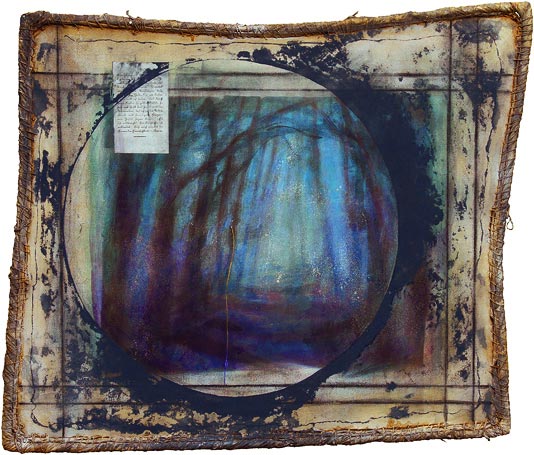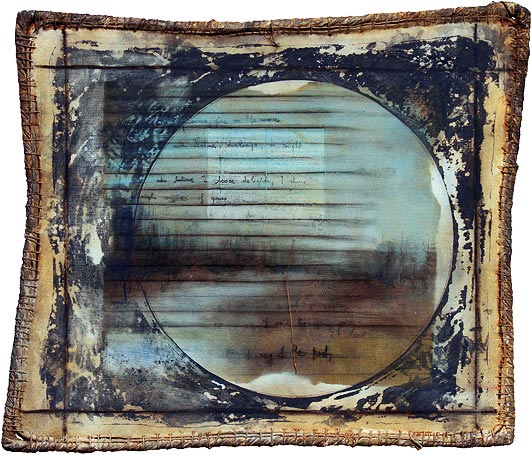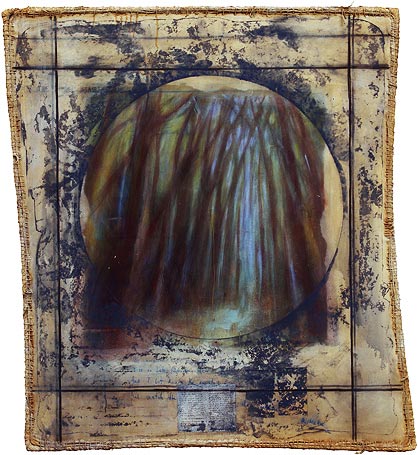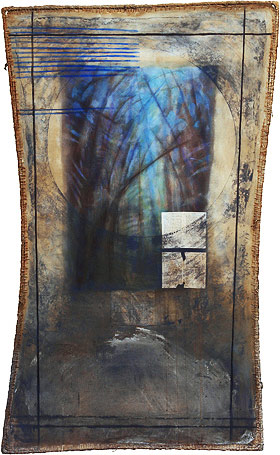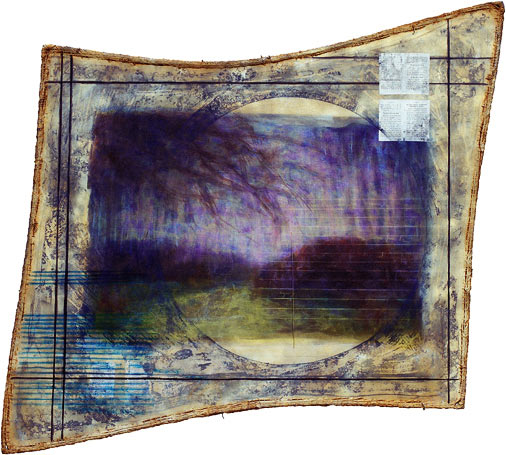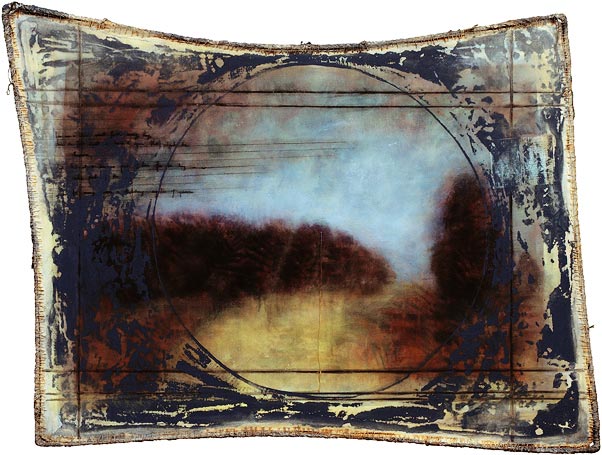Akkad (Hermetic Museum)67×78 cmAcrylic on canvas 2014 |
|||
PAINTINGS 2014 (Cinis Cinereum)
CINIS CINEREUM (Alchemy as Donum Dei)
CINIS CINEREUM (Hermetic Art)
Alchemistic and Symbolical Art
_______________________________________________________________________
Herbert Stanley Redgrove
ALCHEMY: ANCIENT AND MODERN
THE MEANING OF ALCHEMY
1. The Aim of Alchemy
Alchemy is generally understood to have been that art whose end was the transmutation of the so-called base metals into gold by means of an ill-defined something called the Philosopher's Stone; but even from a purely physical standpoint, this is a somewhat superficial view. Alchemy was both a philosophy and an experimental science, and the transmutation of the metals was its end only in that this would give the final proof of the alchemistic hypotheses; in other words, Alchemy, considered from the physical standpoint, was the attempt to demonstrate experimentally on the material plane the validity of a certain philosophical view of the Cosmos. We see the genuine scientific spirit in the saying of one of the alchemists: "Would to God . . . all men might become adepts in our Art -- for then gold, the great idol of mankind, would lose its value, and we should prize it only for its scientific teaching."[1] Unfortunately, however, not many alchemists came up to this ideal; and for the majority of them, Alchemy did mean merely the possibility of making gold cheaply and gaining untold wealth.
2. The Transcendental Theory of Alchemy
By some mystics, however, the opinion has been expressed that Alchemy was not a physical art or science at all, that in no sense was its object the manufacture of material gold, and that its processes were not carried of Alchemy out on the physical plane. According to this transcendental theory, Alchemy was concerned with man's soul, its object was the perfection, not of material substances, but of man in a spiritual sense. Those who hold this view identify Alchemy with, or at least regard it as a branch of, Mysticism, from which it is supposed to differ merely by the employment of a special language; and they hold that the writings of the alchemists must not be understood literally as dealing with chemical operations, with furnaces, retorts, alembics, pelicans and the like, with salt, sulphur, mercury, gold and other material substances, but must be understood as grand allegories dealing with spiritual truths. According to this view, the figure of the transmutation of the "base" metals into gold symbolised the salvation of man -- the transmutation of his soul into spiritual gold -- which was to be obtained by the elimination of evil and the development of good by the grace of God; and the realisation of which salvation or spiritual transmutation may be described as the New Birth, or that condition of being known as union with the Divine. It would follow, of course, if this theory were true that the genuine alchemists were pure mystics, and hence, that the development of chemical science was not due to their labours, but to pseudo-alchemists who so far misunderstood their writings as to have interpreted them in a literal sense.
3. Failure of the Transcendental Theory
This theory, however, has been effectively disposed of by Mr. Arthur Edward Waite, who points to the lives of the alchemists themselves in refutation of it. For their lives indisputably prove that the alchemists were occupied with chemical operations on the physical plane, and that for whatever motive they toiled to discover a method for transmuting the commoner metals into actual, material gold. As Paracelsus himself says of the true "spagyric physicians," who were the alchemists of his period. "These do not give themselves up to ease and idleness . . . But they devote themselves diligently to their labours; sweating whole nights over fiery furnaces. These do not kill the time with empty talk, but find their delight in their laboratory."[2] The writings of the alchemists contain (mixed, however, with much that from the physical standpoint appears merely fantastic) accurate accounts of many chemical processes and discoveries, which cannot be explained away by any method of transcendental interpretation. There is not the slightest doubt that chemistry owes its origin to the direct labours of the alchemists themselves, and not to any who misread their writings.
4. The Qualifications of the Adept
At the same time, it is quite evident that there is a considerable element of Mysticism in the alchemistic doctrines; this has always been recognised; but, as a general rule, those who have approached the subject from the scientific point of view have considered this mystical element as of little or no importance. However, there are certain curious facts which are not satisfactorily explained by a purely physical theory of Alchemy, and, in our opinion, the recognition of the importance of this mystical element and of the true relation which existed between Alchemy and Mysticism is essential for the right understanding of the subject. We may notice, in the first place, that the alchemists always speak of their Art as a Divine Gift, the highest secrets of which are not to be learnt from any books on the subject; and they invariably teach that the right mental attitude with regard to God is the first step necessary for the achievement of the magnum opus. As says one alchemist: "In the first place, let every devout and God-fearing chemist and student of this Art consider that this arcanum should be regarded, not only as a truly great, but as a most holy Art (seeing that it typifies and shadows out the highest heavenly good). Therefore, if any man desire to reach this great and unspeakable Mystery, he must remember that it is obtained not by the might of man, but by the grace of God, and that not our will or desire, but only the mercy of the Most High, can bestow it upon us.
For this reason you must first of all cleanse your heart, lift it up to Him alone, and ask of Him this gift in true, earnest, and undoubting prayer. He alone can give and bestow it."[3] And "Basil Valentine": "First, there should be the invocation of God, flowing from the depth of a pure and sincere heart, and a conscience which should be free from all ambition, hypocrisy, and vice, as also from all cognate faults, such as arrogance, boldness, pride, luxury, worldly vanity, oppression of the poor, and similar iniquities, which should all be rooted up out of the heart -- that when a man appears before the Throne of Grace, to regain the health of his body, he may come with a conscience weeded of all tares, and be changed into a pure temple of God cleansed of all that defiles."[4]
5. Alchemistic Language
In the second place, we must notice the nature of alchemistic language. As we have hinted above, and as is at once apparent on opening any alchemistic book, the language of Alchemy is very highly mystical, and there is much that is perfectly unintelligible in a physical sense. indeed, the alchemists habitually apologise for their vagueness on the plea that such mighty secrets may not be made more fully manifest. It is true, of course, that in the days of Alchemy's degeneracy a good deal of pseudo-mystical nonsense was written by the many impostors then abounding, but the mystical style of language is by no means confined to the later alchemistic writings. It is also true that the alchemists, no doubt, desired to shield their secrets from vulgar and profane eyes, and hence would necessarily adopt a symbolic language. But it is past belief that the language of the alchemist was due to some arbitrary plan; whatever it is to us, it was very real to him. Moreover, this argument cuts both ways, for those, also, who take a transcendental view of Alchemy regard its language as symbolical, although after a different manner. It is also, to say the least, curious, as Mr. A. E. Waite points out, that this mystical element should be found in the writings of the earlier alchemists, whose manuscripts were not written for publication, and therefore ran no risk of informing the vulgar of the precious secrets of Alchemy. On the other hand, the transcendental method of translation does often succeed in making sense out of what is otherwise unintelligible in the writings of the alchemists. The above-mentioned writer remarks on this point: "Without in any way pretending to assert that this hypothesis reduces the literary chaos of the philosophers into a regular order, it may be affirmed that it materially elucidates their writings, and that it is wonderful how contradictions, absurdities, and difficulties seem to dissolve wherever it is applied."[5]
The alchemists' love of symbolism is also conspicuously displayed in the curious designs with which certain of their books are embellished. We are not here referring to the illustrations of actual apparatus employed in carrying out the various operations of physical Alchemy, which are not infrequently found in the works of those alchemists who at the same time were practical chemists (Glauber, for example), but to pictures whose meaning plainly lies not upon the surface and whose import is clearly symbolical, whether their symbolism has reference to physical or to spiritual processes. We shall refer to them again in the course of the present and following chapters.
6. Alchemists of a Mystical Type
We must also notice that, although there cannot be the slightest doubt that the great majority of alchemists were engaged in problems and experiments of a physical nature, yet there were a few men included within the alchemistic ranks who were entirely, or almost entirely, concerned with problems of a spiritual nature; Thomas Vaughan, for example, and Jacob Boehme, who boldly employed the language of Alchemy in the elaboration of his system of mystical philosophy. And particularly must we notice, as Mr. A. E. Waite has also indicated, the significant fact that the Western alchemists make unanimous appeal to Hermes Trismegistos as the greatest authority on the art of Alchemy, whose alleged writings are of an undoubtedly mystical character.[6] It is clear, that in spite of its apparently physical nature, Alchemy must have been in some way closely connected with Mysticism.
7. The Meaning of Alchemy
If we are ever to understand the meaning of Alchemy aright we must look at the subject from the alchemistic point of view. In modern times there has come about a divorce between Religion and Science in men's minds (though more recently a unifying tendency has set in); but it was otherwise with the alchemists, their religion and their science were closely united. We have said that "Alchemy was the attempt to demonstrate experimentally on the material plane the validity of a certain philosophical view of the Cosmos"; now, this "philosophical view of the Cosmos" was Mysticism. Alchemy had its origin in the attempt to apply, in a certain manner, the principles of Mysticism to the things of the physical plane, and was, therefore, of a dual nature, on the one hand spiritual and religious, on the other, physical and material. As the anonymous author of Lives of Alchemystical Philosophers (1815) remarks, "The universal chemistry, by which the science of alchemy opens the knowledge of all nature, being founded on first principles forms analogy with whatever knowledge is founded on the same first principles.... Saint John describes the redemption, or the new creation of the fallen soul, on the same first principles, until the consummation of the work, in which the Divine tincture transmutes the base metal of the soul into a perfection, that will pass the fire of eternity;"[7] that is to say, Alchemy and the mystical regeneration of man (in this writer's opinion) are analogous processes on different planes of being, because they are founded on the same first principles.
8. Opinions of other Writers
We shall here quote the opinions of two modern writers, as to the significance of Alchemy; one a mystic, the other a man of science. Says Mr. A. E. Waite, "If the authors of the `Suggestive Inquiry' and of `Remarks on Alchemy and the Alchemists' [two books putting forward the transcendental theory] had considered the lives of the symbolists, as well as the nature of the symbols, their views would have been very much modified; they would have found that the true method of Hermetic interpretation lies in a middle course; but the errors which originated with merely typographical investigations were intensified by a consideration of the great alchemical theorem, which, par excellence, is one of universal development, which acknowledges that every substance contains undeveloped resources and potentialities, and can be brought outward and forward into perfection. They [the generality of alchemists] applied their theory only to the development of metallic substances from a lower to a higher order, but we see by their writings that the grand hierophants of Oriental and Western alchemy alike were continually haunted by brief and imperfect glimpses of glorious possibilities for man, if the evolution of his nature were accomplished along the lines of their theory."[8] Mr. M. M. Pattison Muir, M.A., says: ". . . alchemy aimed at giving experimental proof of a certain theory of the whole system of nature, including humanity. The practical culmination of the alchemical quest presented a threefold aspect; the alchemists sought the stone of wisdom, for by gaining that they gained the control of wealth; they sought the universal panacea, for that would give them the power of enjoying wealth and life; they sought the soul of the world, for thereby they could hold communion with spiritual existences, and enjoy the fruition of spiritual life. The object of their search was to satisfy their material needs, their intellectual capacities, and their spiritual yearnings. The alchemists of the nobler sort always made the first of these objects subsidiary to the other two...."[9]
9. The Basic Idea of Alchemy
The famous axiom beloved by every alchemist -- "What is above is as that which is below, and what is below is as that which is above" -- although of quesable{sic} origin, tersely expresses the basic idea of Alchemy. The alchemists postulated and believed in a very real sense in the essential unity of the Cosmos. Hence, they held that there is a correspondence or analogy existing between things spiritual and things physical, the same laws operating in each realm. As writes Sendivogius ". . . the Sages have been taught of God that this natural world is only an image and material copy of a heavenly and spiritual pattern; that the very existence of this world is based upon the reality of its celestial archetype; and that God has created it in imitation of the spiritual and invisible universe, in order that men might be the better enabled to comprehend His heavenly teaching, and the wonders of His absolute and ineffable power and wisdom. Thus the Sage sees heaven reflected in Nature as in a mirror; and he pursues this Art, not for the sake of gold or silver, but for the love of the knowledge which it reveals; he jealously conceals it from the sinner and the scornful, lest the mysteries of heaven should be laid bare to the vulgar gaze."[10]
The alchemists held that the metals are one in essence, and spring from the same seed in the womb of nature, but are not all equally matured and perfect, gold being the highest product of Nature's powers. In gold, the alchemist saw a picture of the regenerate man, resplendent with spiritual beauty, overcoming all temptations and proof against evil; whilst he regarded lead -- the basest of the metals -- as typical of the sinful and unregenerate man, stamped with the hideousness of sin and easily overcome by temptation and evil; for whilst gold withstood the action of fire and all known corrosive liquids (save aqua regia alone), lead was most easily acted upon. We are told that the Philosopher's Stone, which would bring about the desired grand transmutation, is of a species with gold itself and purer than the purest; understood in the mystical sense this means that the regeneration of man can be effected only by Goodness itself -- in terms of Christian theology, by the Power of the Spirit of Christ. The Philosopher's Stone was regarded as symbolical of Christ Jesus, and in this sense we can understand the otherwise incredible powers attributed to it.
10. The Law of Analogy
With the theories of physical Alchemy we shall deal at length in the following chapter, but enough has been said to indicate the analogy existing, according to the alchemistic view, between the problem of the perfection of the metals, i.e., the transmutation of the "base" metals into gold, and the perfection or transfiguration of spiritual man; and it might also be added, between these problems and that of the perfection of man considered physiologically. To the alchemistic philosopher these three problems were one: the same problem on different planes of being; and the solution was likewise one. He who held the key to one problem held the key to all three, provided he understood the analogy between matter and spirit. The point is not, be it noted, whether these problems are in reality one and the same; the main doctrine of analogy, which is, indeed, an essential element in all true mystical philosophy, will, we suppose, meet with general consent; but it will be contended (and rightly, we think) that the analogies drawn by the alchemists are fantastic and by no means always correct, though possibly there may be more truth in them than appears at first sight. The point is not that these analogies are correct, but that they were regarded as such by all true alchemists. Says the author of The Sophic Hydrolith: ". . . the practice of this Art enables us to understand, not merely the marvels of Nature, but the nature of God Himself, in all its unspeakable glory. It shadows forth, in a wonderful manner . . . all the articles of the Christian faith, and the reason why man must pass through much tribulation and anguish, and fall a prey to death, before he can rise again to a new life."[11] A considerable portion of this curious alchemistic work is taken up in expounding the analogy believed to exist between the Philosopher's Stone and "the Stone which the builders rejected," Christ Jesus; and the writer concludes: "Thus . . . I have briefly and simply set forth to you the perfect analogy which exists between our earthly and chemical and the true and heavenly Stone, Jesus Christ, whereby we may attain unto certain beatitude and perfection, not only in earthly but also in eternal life."[12] And likewise says Peter Bonus: "I am firmly persuaded that any unbeliever who got truly to know this Art, would straightway confess the truth of our Blessed Religion, and believe in the Trinity and in our Lord Jesus Christ."[13]
11. The Dual Nature of Alchemy
For the most part, the alchemists were chiefly engaged with the carrying out of the alchemistic theory on the physical plane, i.e., with the attempt to transmute the "base" metals into the "noble" ones; some for the love of knowledge, but alas! the vast majority for the love of mere wealth. But all who were worthy of the title of "alchemist" realised at times, more or less dimly, the possibility of the application of the same methods to man and the glorious result of the transmutation of man's soul into spiritual gold. There were a few who had a clearer vision of this ideal, those who devoted their activities entirely, or almost so, to the attainment of this highest goal of alchemistic philosophy, and concerned themselves little if at all with the analogous problem on the physical plane. The theory that Alchemy originated in the attempt to demonstrate the applicability of the principles of Mysticism to the things of the physical realm brings into harmony the physical and transcendental theories of Alchemy and the various conflicting facts advanced in favour of each. It explains the existence of the above-mentioned, two very different types of alchemists. It explains the appeal to the works attributed to Hermes, and the presence in the writings of the alchemists of much that is clearly mystical. And finally, it is in agreement with such statements as we have quoted above from The Sophic Hydrolith and elsewhere, and the general religious tone of the alchemistic writings.
12. "Body, Soul and Spirit"
In accordance with our primary object as stated in the preface, we shall confine our attention mainly to the physical aspect of Alchemy; but in order to understand its theories, it appears to us to be essential to realise the fact that Alchemy was an attempted application of the principles of Mysticism to the things of the physical world. The supposed analogy between man and the metals sheds light on what otherwise would be very difficult to understand. It helps to make plain why the alchemists attributed moral qualities to the metals -- some are called "imperfect," "base"; others are said to be "perfect," "noble." And especially does it help to explain the alchemistic notions regarding the nature of the metals. The alchemists believed that the metals were constructed after the manner of man, into whose constitution three factors were regarded as entering: body, soul, and spirit. As regards man, mystical philosophers generally use these terms as follows: "body" is the outward manifestation and form; "soul" is the inward individual spirit;[14] and "spirit" is the universal Soul in all men. And likewise, according to the alchemists, in the metals, there is the "body" or outward form and properties, "metalline soul" or spirit,[15] and finally, the all-pervading essence of all metals. As writes the author of the exceedingly curious tract entitled The Book of Lambspring. "Be warned and understand truly that two fishes are swimming in our sea," illustrating his remark by the symbolical picture reproduced in plate 2, and adding in elucidation thereof, "The Sea is the Body, the two Fishes are Soul and Spirit."[16] The alchemists, however, were not always consistent in their use of the term "spirit." Sometimes (indeed frequently) they employed it to denote merely the more volatile portions of a chemical substance; at other times it had a more interior significance.
13. Alchemy, Mysticism and Modern Science
We notice the great difference between the alchemistic theory and the views regarding the constitution of matter which have dominated Chemistry since the time of Dalton. But at the present time Dalton's theory of the chemical elements is undergoing a profound modification. We do not imply that Modern Science is going back to any such fantastic ideas as were held by the alchemists, but we are struck with the remarkable similarity between this alchemistic theory of a soul of all metals, a one primal element, and modern views regarding the ether of space. In its attempt to demonstrate the applicability of the fundamental principles of Mysticism to the things of the physical realm Alchemy apparently failed and ended its days in fraud. It appears, however, that this true aim of alchemistic art -- particularly the demonstration of the validity of the theory that all the various forms of matter are produced by an evolutionary process from some one primal element or quintessence -- is being realised by recent researches in the domain of physical and chemical science.
(Herbert Stanley Redgrove (1887–1943); Alchemy: Ancient and Modern, pp. 11-18.)
________________________________
Notes:
[1] "EIRENÆUS PHILALETHES": An Open Entrance to the Closed Palace of the King (see The Hermetic Museum, Restored and Enlarged, edited by A. E. Waite, 1893, vol. ii. p. 178).
[2] PARACELSUS: "Concerning the Nature of Things" (see The Hermetic and Alchemical Writings of Paracelsus, edited by A. E Waite, 1894, vol. i. p. 167).
[3] The Sophic Hydrolith; or, Water Stone of the Wise (see The Hermetic Museum, vol. i. p. 74).
[4] The Triumphal Chariot of Antimony (Mr. A. E. Waite's translation, p. 13). See 41.
[5] ARTHUR EDWARD WAITE: The Occult Sciences (1891), p. 91.
[6] Hermes Tismegistos. Having now considered the chief points in the theory of Physical Alchemy, we must turn our attention to the lives and individual teachings of the alchemists themselves. The first name which is found in the history of Alchemy is that of Hermes Trismegistos. We have already mentioned the high esteem in which the works ascribed to this personage were held by the alchemists. He has been regarded as the father of Alchemy; his name has supplied a synonym for the Art -- the Hermetic Art -- and even to-day we speak of hermetically sealing flasks and the like. But who Hermes actually was, or even if there were such a personage, is a matter of conjecture. The alchemists themselves supposed him to have been an Egyptian living about the time of Moses. He is now generally regarded as purely mythical -- a personification of Thoth, the Egyptian God of learning; but, of course, some person or persons must have written the works attributed to him, and the first of such writers (if, as seems not unlikely, there were more than one) may be considered to have a right to the name. Of these works, the Divine Pymander, (Dr. Everard's translation of this work forms vol. ii. of the Collectanea Hermetica, edited by W. Wynn Westcott, M. B., D.P.H. It is now, however, out of print.) a mystical-religious treatise, is the most important. The Golden Tractate, also attributed to Hermes, which is an exceedingly obscure alchemistic work, is now regarded as having been written at a comparatively late date.
[7] F. B.: Lives of Alchemystical Philosophers (1815), Preface, p. 3.
[8] ARTHUR EDWARD WAITE: Lives of Alchemystical Philosophers (1888), pp. 30, 31. As says another writer of the mystical school of thought: "If we look upon the subject [of Alchymy] from the point which affords the widest view, it may be said that Alchymy has two aspects: the simply material, and the religious. The dogma that Alchymy was only a form of chemistry is untenable by any one who has read the works of its chief professors. The doctrine that Alchymy was religion only, and that its chemical references were all blinds, is equally untenable in the face of history, which shows that many of its most noted professors were men who had made important discoveries in the domain of common chemistry, and were in no way notable as teachers either of ethics or religion" ("Sapere Aude," The Science of Alchymy, Spiritual and Material (1893), pp. 3 and 4).
[9] M. M. PATTISON MUIR, M.A.: The Story of Alchemy and the Beginnings of Chemistry (1902), pp. 105 and 106.
[10] MICHAEL SENDIVOGIUS: The New Chemical light, Pt. II., Concerning Sulphur (The Hermetic Museum, vol. ii. p. 138).
[11] The Sophic Hydrolith; or, Water Stone of the Wise (see The Hermetic Museum, vol. i. p. 88).
[12] Ibid. p. 114.
[13] PETER BONUS: The New Pearl of Great Price (Mr. A. E. Waite's translation, p. 275).
[14] Which, in virtue of man's self-consciousness, is, by the grace of God, immortal.
[15] See the work Of Natural and Supernatural Things, attributed to "Basil Valentine," for a description of the "spirits" of the metals in particular.
[16] The Book of Lambspring, translated by Nicholas Barnaud Delphinas (see the Hermetic Museum, vol. i. p. 277). This work contains many other fantastic alchemistic symbolical pictures, amongst the most curious series in alchemistic literature.
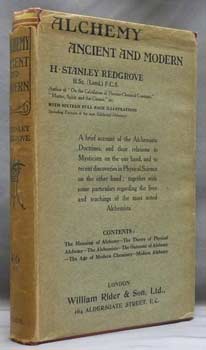
_______________________________________________________________________
Alchemistic and Symbolical Art



